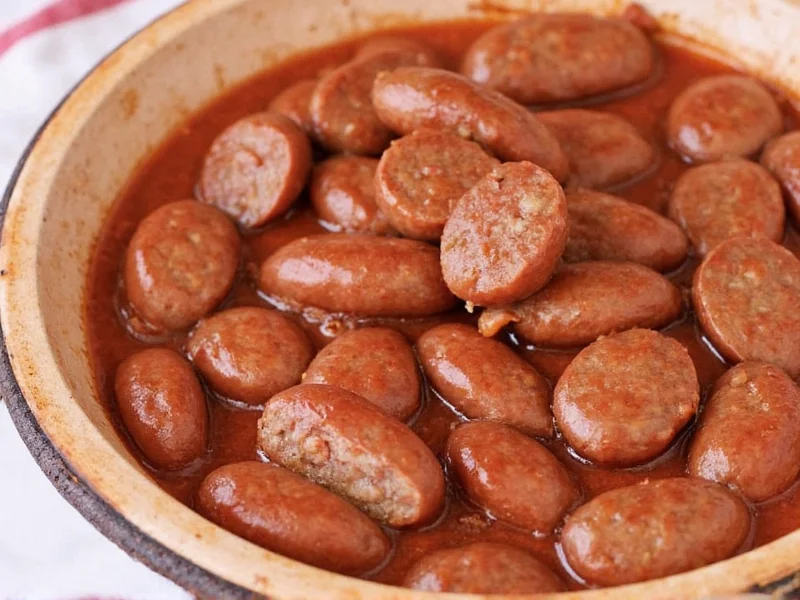Creating delicious homemade sausage doesn't require professional equipment or years of experience. This comprehensive guide reveals traditional sausage making techniques adapted for modern home kitchens. Whether you're crafting breakfast links, Italian-style sausages, or custom blends, understanding the fundamentals transforms your results from mediocre to exceptional.
Essential Equipment for Homemade Sausage
While dedicated sausage stuffers produce professional results, you can make excellent sausage with basic kitchen tools. The critical factor is maintaining proper temperatures throughout the process to ensure food safety and optimal texture.
| Equipment | Essential? | Home Kitchen Alternative |
|---|---|---|
| Meat grinder | Required | Stand mixer attachment or hand-crank grinder |
| Sausage stuffer | Recommended | Grinder tube with stuffing horn attachment |
| Casing preparation tools | Helpful | Colander and clean kitchen towel |
| Instant-read thermometer | Required | Digital probe thermometer |
Mastering the Meat-to-Fat Ratio
Understanding the best meat to fat ratio for homemade sausage separates good sausage from great sausage. Most traditional recipes follow the 70/30 rule—70% lean meat to 30% fat. This ratio applies whether you're making pork, beef, or poultry sausage. For breakfast sausage, you might increase fat to 35% for richer flavor.
When selecting meat, choose well-marbled cuts like pork shoulder (Boston butt) which naturally contains the ideal fat distribution. Avoid lean cuts that require excessive added fat, as this creates an unnatural texture. Always chill your meat and fat to 28-30°F (-2 to -1°C) before grinding—this prevents smearing and ensures clean cuts through the grinder plates.
Seasoning Science: Building Flavor Profiles
Professional butchers follow precise seasoning measurements rather than vague "to taste" instructions. The standard seasoning ratio is 3% of the total meat weight. For a 5-pound batch:
- Salt: 28g (1.8% of meat weight)
- Spices: 14g (0.9% of meat weight)
- Sugar: 7g (0.45% of meat weight)
- Nitrite cure (for smoked sausages): 2.5g per 5lbs
Always dissolve salt in a small amount of ice water before mixing—it helps distribute evenly and improves protein extraction. For authentic homemade Italian sausage recipe variations, include fennel pollen instead of seeds for brighter flavor, and use both sweet and hot paprika rather than red pepper flakes for more complex heat.
Step-by-Step Sausage Making Process
Follow these steps for perfect results every time you attempt this easy homemade sausage recipe for beginners:
- Soak natural casings in cold water for 30 minutes, then rinse internally under running water
- Chill all equipment and ingredients thoroughly (critical for food safety guidelines for homemade sausage)
- Grind meat and fat through coarse plate (⅜ inch), then fine plate (¼ inch) into chilled bowl
- Mix in dissolved salt and seasonings using clean hands for 2-3 minutes until sticky
- Refrigerate mixture for 12-24 hours for flavor development (don't skip this step!)
- Test a small patty in simmering water to check seasoning and texture
- Stuff into prepared casings, twisting into desired lengths
Troubleshooting Common Issues
Even experienced sausage makers encounter problems. Here's how to fix them:
- Crumbly texture: Insufficient fat or improper protein extraction. Ensure proper chilling and adequate mixing time.
- Watery sausage: Meat temperature rose too high during grinding. Keep everything cold and work quickly.
- Casings breaking: Overstuffing or inconsistent thickness. Fill casings only 80% full and maintain steady pressure.
- Bland flavor: Skipping the resting period. The 12-24 hour refrigeration allows flavors to meld properly.
Variation Ideas for Custom Sausage Blends
Once you've mastered the basic technique, experiment with these popular variations:
- Breakfast Sausage: Add maple syrup, sage, and a touch of nutmeg to pork mixture
- Chorizo: Incorporate smoked paprika, garlic, and vinegar for authentic Spanish flavor
- Chicken Apple: Use 75% chicken thigh, 25% pork fat, with fresh apple and thyme
- Bratwurst: Include fresh marjoram, nutmeg, and a splash of beer in the mixture
Storage and Cooking Guidelines
Proper homemade sausage storage tips ensure safety and quality:
- Refrigerate fresh sausage for up to 2 days before cooking
- Freeze uncooked sausage for up to 3 months (vacuum sealing extends freshness)
- Never thaw sausage at room temperature—always use refrigerator thawing
- Cook to internal temperature of 160°F (71°C) for pork/beef, 165°F (74°C) for poultry
For best cooking results, poach sausages in 160-170°F (71-77°C) water for 15-20 minutes before finishing on the grill or in a pan. This ensures even cooking without splitting casings.
Frequently Asked Questions
Can I make sausage without special equipment?
Yes, you can make excellent sausage with basic kitchen tools. Use a food processor with quick pulses to chop rather than grind meat, and stuff casings using a funnel attached to a plastic bottle. The key is maintaining proper temperatures throughout the process.
What's the best meat for beginner sausage makers?
Pork shoulder (Boston butt) is ideal for beginners because it naturally contains the perfect 70/30 meat-to-fat ratio. It's forgiving, widely available, and produces consistently excellent results for your first homemade sausage recipe attempts.
How do I prevent my sausage from being dry?
Maintain the proper 70/30 meat-to-fat ratio and never skip the resting period before cooking. Overmixing or using meat that's too warm during preparation also causes dryness. Always test a small patty first to check moisture levels before committing to the entire batch.
Can I use artificial casings for homemade sausage?
While natural casings produce superior texture and appearance, collagen casings work well for beginners. Avoid plastic casings for fresh sausage—they're designed only for smoked products. For the best results with how to make sausage without special equipment, natural hog casings remain the top choice.
How long should I let sausage mixture rest before stuffing?
Allow the seasoned meat mixture to rest in the refrigerator for 12-24 hours before stuffing. This crucial step lets the salt dissolve proteins, creating a sticky mixture that binds properly and develops deeper flavors—something many easy homemade sausage recipe guides overlook.











 浙公网安备
33010002000092号
浙公网安备
33010002000092号 浙B2-20120091-4
浙B2-20120091-4